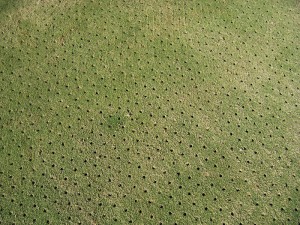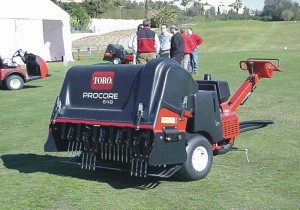MIJAS GOLF CLUB – MANTENIMIENTO DEL GREEN – GREEN’S MAINTENANCE
ESPAÑOL
Pinchado del Green
La diferencia entre un Green y una planta de nuestra casa es que el Green sufre continuamente las pisadas de los jugadores, la pesada maquinaria del campo de golf y las agresiones de las bolas de golf que golpean y compactan la tierra al caer desde cierta altura en los golpes de aproximación. Por eso es tan importante el uso del arregla-piques.
Al compactar la tierra se hace menos mullida, menos esponjosa, y el agua se estanca en la superficie y no llega a las capas más profundas, aquellas en las que se encuentran las raíces del césped del Green, y lo mismo pasa también con el aire.
El pinchado es una labor de aireación de los Greenes y dentro de las labores hay dos diferentes maneras, que dependen del tipo de pincho: Hueco y macizo. El micro-pinchado es aquel en el que se usan tubos macizos de pequeño calibre y que no afecta al juego, y el pinchado-hueco o pinchado a secas que es el que normalmente se llama sacabocados y que si afecta al juego en el Green.
El pinchado es un proceso mecánico que crea más espacio de aire en el suelo y favorece el enraizamiento profundo, ayudando así a la hierba a mantenerse saludable. Al eliminar la capa de thatch (materia orgánica) se impide que ésta se concentre en la superficie, lo que predispondría a que los Greenes se vuelvan blandos y lentos. Asimismo, favorece el desarrollo de microorganismos que benefician el crecimiento del césped. Y por último, facilita un buen drenaje e infiltración de agua.
Dependiendo de la finalidad que se busque en un campo de golf, se deben realizar micro-pinchados mensuales y – en condiciones normales – dos anuales con los huecos.
¿En qué época del año debe hacerse y porque es necesario?
Normalmente, el pinchado importante de los Greenes (el que se nota en el juego) se efectúa antes de la llegada de las temperaturas altas del verano (en primavera) y de la llegada de las bajas temperaturas del invierno/otoño, para dotar al césped de las mejores condiciones posibles antes de las estaciones más adversas, por sus temperaturas extremas y periodos de lluvia variables.
El suelo del Green debe tener un equilibrio entre sólidos (50%), aire (25%) y agua (25%). Con el tráfico de jugadores que soporta el campo de golf este equilibrio se pierde, y en consecuencia se pierde también el espacio disponible para oxigeno y agua (compactación). Con el pinchado se consigue recuperar dicho equilibrio, y se crean los conductos de entrada de agua y nutrientes tan necesarios para la planta.
En invierno estos conductos sirven para facilitar la entrada de agua de lluvia y limpiar el exceso de sales que se acumulan, a causa del uso de aguas regeneradas. En verano son necesarios para que el agua llegue a las raíces y evitar así que se pierda por evaporación la menor cantidad posible de agua.
Todo jugador de golf debe comprender que airear (pinchar) los Greenes del campo de golf al menos 2 veces al año es imprescindible para lograr un buen mantenimiento y un césped saludable. Los beneficios del pinchado son incuestionables.
El césped que conforma el Green, al igual que cualquier tipo de planta y al tratarse de un ser vivo, necesita una óptima combinación de agua, tierra y aire, ya que si compactamos en exceso la tierra la planta podría morir.
Además el pinchado es la forma más efectiva de minimizar los efectos indeseables de la excesiva acumulación de colchón.
Procedimiento y desarrollo del pinchado
El pinchado del Green consiste básicamente en clavar en la tierra unos tubos huecos, los cuáles producen pequeños agujeros que posteriormente son tapados con arena (recebo). Estos huecos permiten el filtrado del aire y la descompactación de la tierra a su alrededor.
Lo primero que se debe hacer es abonar el Green para que la planta coja fuerza y aguante el proceso de pinchado. Posteriormente se pincha el Green con una máquina específica, la cual extrae del suelo pequeños tapones de 2-3 cm de diámetro y 5-6 cm de profundidad. Una vez pinchado el Green, se limpia la superficie y se procede a extender una capa de arena (lo que comúnmente se denomina recebar) que servirá de nuevo sustrato para cubrir los agujeros.
Esta arena facilita el paso del aire y el agua, imprescindibles para el correcto desarrollo del césped.
El proceso de recuperación del Green suele durar entre de 7-12 días (dependiendo de las condiciones climatológicas) y sólo se suele hacer dos veces al año, para contar con 48 semanas de Greenes perfectos, firmes y rápidos. Pasado ese tiempo de recuperación, los Greenes del campo estarán otra vez en perfectas condiciones, y podremos disfrutar de este magnífico deporte que nos anima cada día a superarnos.
ENGLISH
Hollow tinning of the Green
The difference between a green and plant at home is that the green is continually suffering the player’s footsteps, the weight of heavy machinery of the golf course and the aggression of the golf balls hitting and compressing the ground. Therefore it is very important the use of the pitch-repairs.
This soil’s compaction makes the dump less soft, less fluffy, and therefore the water stands on the surface and does not reach the deeper layers, those in which the plant roots, and the same happens with the air.
The hollow tinning is a work of aeration of the greens, there are two different ways to do it depending on the type of spike, hollow and solid: The micro one is when solid small-bore tubes are used and does not affect the game; and the major one, which is normally called hollow tinning or spiking works and affects the game on the green.
The aerification is a mechanical process that creates more air space in the soil and benefits deep rooting, helping the lawn to stay healthy. Removing the thatch layer (organic matter) avoid its concentration on the surface, which predispose the greens to become soft and slow. It also promotes the development of microorganisms that benefit the growth of grass; and finally provides good drainage and water infiltration.
Depending on the purpose you search at a golf course, should be performed in a monthly basis with the micro-hollow tinning and twice a year with the major hollow tinning one.
What time of year should be done and why it is needed?
Normally, the major spiking works of the greens (which we will notice in the game), takes place before the arrival of high summer temperatures (spring) and before the arrival of the low temperatures of winter / fall, to leave the course in the best possible conditions before the hardest seasons’ extreme temperatures and variable periods of rain.
The green soil must have a balance between solid (50%), air (25%) and water (25%). Due to the player’s traffic suffered by the golf course this balance is lost and, therefore, the space available for oxygen and water (compaction) is also vanished. With the hollow tinning works that balance is restored and the inlet water and nutrients, that are so necessary, are produced.
In winter these ducts are good to facilitate the entry of rain water and to wipe the excess of accumulated salts due to the use of reclaimed water. In summer they are necessary for the water to reach the roots and to ensure that the least amount of water is lost by evaporation.
Every golfer should understand that to aerate (hollow tinning) the greens of the golf course at least 2 times a year is essential to achieve good maintenance and a healthy grass. The benefits of the spiking works are unquestionable.
The grass that makes up the green, like any other plant and as it is a living being, requires an optimal combination of water, sand and air, because if we compact the soil too much the plant may die.
In addition, the hollow tinning is the most effective way to minimize the undesirable effects of excessive accumulation of mattress.
Development & Procedure
Basically, the hollow tinning is to stick some hollow tubes in the ground, which will produce the small holes that are covered afterwards with sand (top dressing). These little holes will allow air filtration and descompaction of the ground around it.
The first thing it should be done is to fertilize the green for the plant strengthening to endure the spiking process. Later, the green is treated with a specific machine, which extract small plugs of 2-3 cm in diameter and 5-6 cm deep from the ground. Once the green has been punched, the surface must be cleaned and it is proceeded to spread a layer of sand (commonly called re-priming) which will be used as a new substratum to cover the holes.
This sand will help water and air filtration, which is essential for the proper development of the grass.
The green recovery process usually takes between 7-12 days (depending on weather conditions) and is usually done only twice a year, to have 48 weeks of perfect, firm and fast greens. After this recovery time, the greens will be again in perfect conditions, and we will be able to enjoy this wonderful sport that inspires us to improve ourselves everyday.



